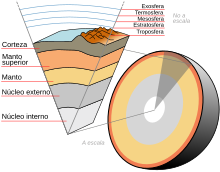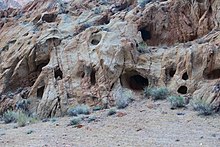Earth sciences
The Earth sciences are a group of disciplines whose objective is the study of the planet Earth, including its interaction with the rest of the universe and the evolution of the living beings that inhabit it. This discipline includes various areas of knowledge, such as: geosciences, atmospheric sciences, marine sciences, environmental sciences, cryospheric sciences, limnology, forestry sciences, soil sciences, physical geography, paleontology, landscape ecology and planetary sciences.
Earth sciences constitute a tool to plan a rational exploitation of natural resources, to understand the causes that originate natural phenomena that affect human beings and how they influence nature with their actions.
On the other hand, the Earth sciences allow us to understand the natural processes that have favored and/or threatened human life, and their study is linked both to the study of energy flows in nature and to the use of the same, as to the prevention of environmental, seismic, meteorological and volcanic risks, among others.
A system is a set of elements that are related and interact with each other. The planet is a complex system whose components tend to balance,[citation required] is say that movements in one direction are offset by others in the opposite direction. Any change that occurs in any element of the system directly or indirectly affects others.
Geosciences, equivalent to Earth Sciences and is one of those post-modern terms that have been invented to account for the set of scientific disciplines that build knowledge about the Earth, to understand the complex and varied processes involved in evolution, since its birth as a planet
Internal processes generate reliefs, that is, higher or lower places. The external processes wear away the highest reliefs and deposit in other places the materials produced by that wear or erosion, which maintains the balance of the physical system.
Endogenous or internal processes occur inside the Earth such as plate tectonics. The boundaries between tectonic plates are classified into three types: convergence, divergence, and transforms. The movement of tectonic plates can produce orogeny, mountain formation, by stacking or deformation of the crust (folding and fracturing) and phenomena such as earthquakes, magmatism, metamorphism and volcanism, as well as the creation and destruction of crust.
The exogenous or external processes that take place on the earth's surface intervene in the transformation of the relief through erosion, which consists of the wear and tear of the earth's surface; the transport of wear materials to other areas, and their subsequent accumulation. According to the agent that acts, erosion can be classified as: wind, fluvial, marine, pluvial, glacial, mechanical and anthropic.
Particularities regarding other sciences
Earth sciences encompasses the temporal and spatial study of the planet from a physical point of view, including its interaction with living things. The varied spatio-temporal scales of the Earth's structure and history mean that the processes that take place on it are the result of a complex interaction between processes of different spatial (from a millimeter to thousands of kilometers) and temporal scales, which They range from hundredths of a second to billions of years. An example of this complexity is the different mechanical behavior that some rocks have depending on the processes being studied: while the rocks that make up the upper mantle respond elastically to the passage of seismic waves (with typical periods of fractions of a second), they behave like a fluid on the time scales of plate tectonics
Since the object of study (the Earth) is not manipulable and obtaining direct data is limited, analog or computational simulation techniques are of some use.
History
Earth sciences are constantly evolving. Pliny the Elder's geography only described the elements of the Earth's surface without linking them through processes, and little importance was given to the dynamics of changes and interaction with the elements that make up the environment. During the first centuries of European exploration, a stage of much more detailed knowledge of the continents and oceans began. For example, magnetic alignments in the Atlantic Ocean, which would be very useful for intercontinental navigation, were mapped in detail. In 1596, for example, Abraham Ortelius already glimpsed the hypothesis of continental drift, a precursor of the theory of plate tectonics. Previously, Spanish and Portuguese explorers had accumulated a detailed knowledge of the Earth's magnetic field. The birth of the basic concepts of geology (gradualism, superposition, etc), in the XVII and XVIII (eg, James Hutton) or meteorology, gave way to an explosion in the study of the Earth. Today, the Earth sciences are part of the quantitative physical sciences based on empiricism, experimentation and the reproducibility of observations. On the other hand, they are also sciences that help to improve the understanding of planet Earth, in order to provide answers to the challenges of preserving the environment and achieving sustainable development.
Disciplines
- Solid Earth Study:
- Geophysics, study of the planet from the point of view of physics. Geological phenomena are analyzed and modeled in order to achieve a mathematical and geometric description of them. It includes disciplines such as geodynamics or seismology.
- Geology, studies the internal and external dynamics of the earth, regarding the rocks and their structure, the mineral deposits, the evolution of the planet, phenomena such as the tectonic of plates, the orogeny, earthquakes, vulcanism, avalanches, floods, etc.
- Stratigraphy, studies sedimentary, metamorphic and stratified volcanic rocks, sedimentary basins, paleogeography, geological record discontinuities and the global stratigraphic scale.
- Historical Geology, studies the transformations that the Earth has experienced since its formation, about 4570 million years ago, to the present.
- Geomorphology, studies the forms of the terrestrial surface, related to the structures and litology of the subsoil and the erosive processes that shape the surface.
- Paleoclimatology, studies the climatic characteristics of the Earth throughout its history.
- Paleogeography, studies the distribution throughout the geological times of the continental masses and oceans in general, of the evolution of Orogenias, sedimentary basins, and of sedimentary media in detail.
- Petrograph, deals with the description of rocks, especially structures, textures and mineral composition.
- Petrologystudies the composition and formation of rocks, their physical and chemical properties, mineral, spatial and chronological relations, and mineral associations (paragenesis) and rocky. Study the igneous, metamorphic and sedimentary rocks.
- Sedimentology, studies the processes of formation, transport and deposition of the material that accumulates as sediment in continental and marine environments and which ultimately form sedimentary rocks. Try to interpret and reconstruct the sedimentary environments of the past.
- Tectonic, studies the geological structures produced by deformation of the earth's crust, which the rocks acquire after being formed, as well as the processes that originate them. It analyzes the mechanics and dynamics of the lithosphere, to give explanation to deformations (plies and faults) and structural formations such as tectonic plates.
- Vulcanology, studies vulcanism, magmatism and other related geological phenomena.
- Geographystudies the relation and interaction of the earth's surface with man.
- Geochemistrystudies the absolute and relative abundance, distribution and migration of the elements that make up the Earth.
- Paleontologystudies and interprets the past of life on Earth through fossils. It describes the evolution of life on our planet. Paleontological data provide chronoestratigraphic, paleogeographic, paleocology, catastrophic events of the past, etc.
- Ground science, studies soil as a natural resource.
- Geodesy, studies the earth considering its curvature.
- Climatology, study of the current terrestrial climate and the geological past.
- Hydrology, studies the distribution, spatial and temporal, and the properties of the water present in the atmosphere and in the terrestrial crust.
- Meteorologystudies atmospheric dynamics and weather.
- Oceanography u oceanologystudies ocean dynamics such as tides, waves and currents. Study ocean life and soil in order to achieve a complete understanding of the formation and evolution of planet Earth (study of pits, dorsals, islands and submerged mountain ranges).
- Biogeography It is an interdisciplinary science between Biology and Geography, which studies the distribution of living beings on Earth.
Contenido relacionado
Erythropsis
Ciato
Alvimia




